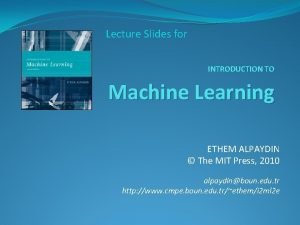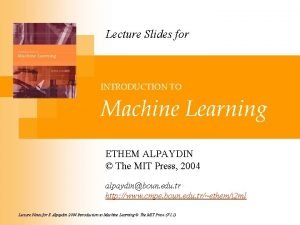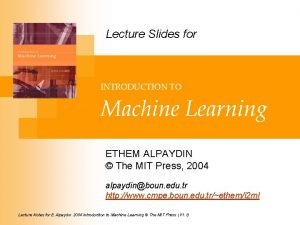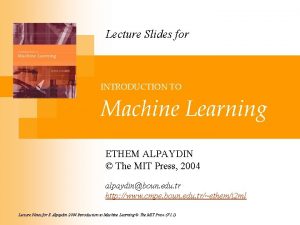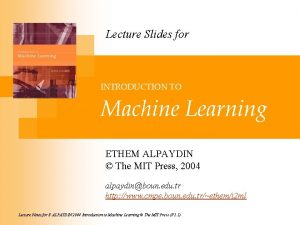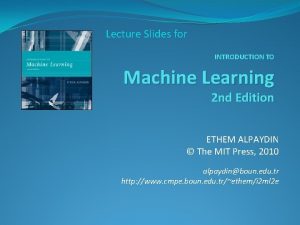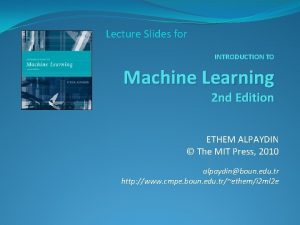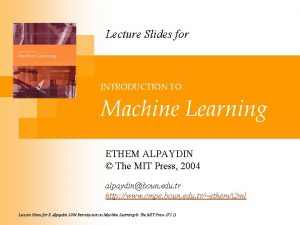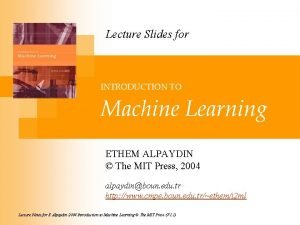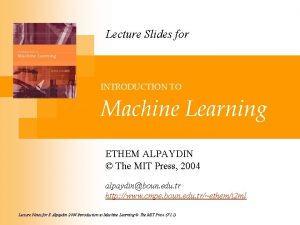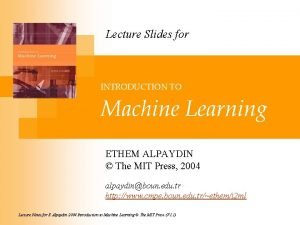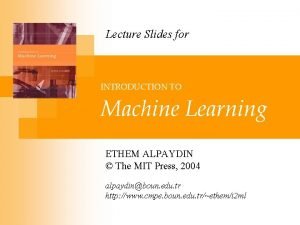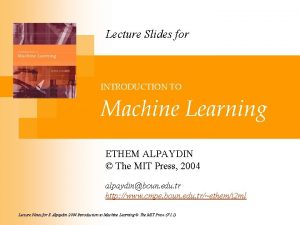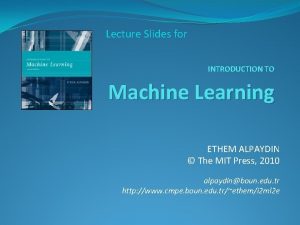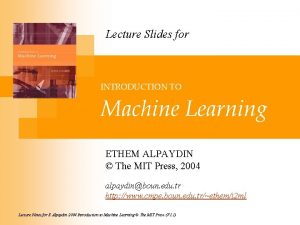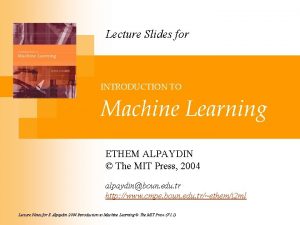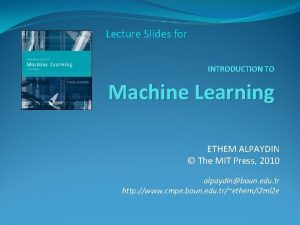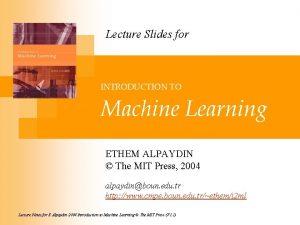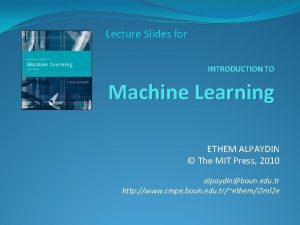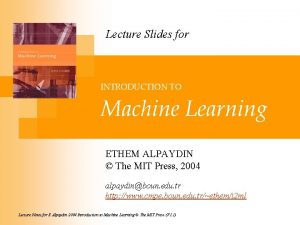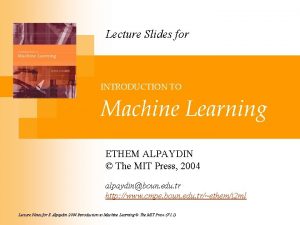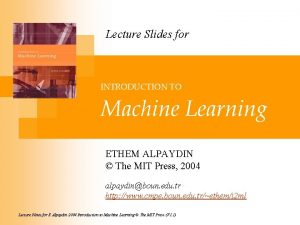Lecture Slides for INTRODUCTION TO Machine Learning ETHEM





















- Slides: 21

Lecture Slides for INTRODUCTION TO Machine Learning ETHEM ALPAYDIN © The MIT Press, 2004 alpaydin@boun. edu. tr http: //www. cmpe. boun. edu. tr/~ethem/i 2 ml Lecture Notes for E Alpaydın 2004 Introduction to Machine Learning © The MIT Press (V 1. 1)

CHAPTER 6: Dimensionality Reduction Lecture Notes for E Alpaydın 2004 Introduction to Machine Learning © The MIT Press (V 1. 1)

Why Reduce Dimensionality? 1. 2. 3. 4. 5. 6. Reduces time complexity: Less computation Reduces space complexity: Less parameters Saves the cost of observing the feature Simpler models are more robust on small datasets More interpretable; simpler explanation Data visualization (structure, groups, outliers, etc) if plotted in 2 or 3 dimensions 3 Lecture Notes for E Alpaydın 2004 Introduction to Machine Learning © The MIT Press (V 1. 1)

Feature Selection vs Extraction n n Feature selection: Choosing k<d important features, ignoring the remaining d – k Subset selection algorithms Feature extraction: Project the original xi , i =1, . . . , d dimensions to new k<d dimensions, zj , j =1, . . . , k Principal components analysis (PCA), linear discriminant analysis (LDA), factor analysis (FA) 4 Lecture Notes for E Alpaydın 2004 Introduction to Machine Learning © The MIT Press (V 1. 1)

Subset Selection n n There are 2 d subsets of d features Forward search: Add the best feature at each step Set of features F initially Ø. ¨ At each iteration, find the best new feature j = argmini E ( F È xi ) ¨ Add xj to F if E ( F È xj ) < E ( F ) ¨ n n n Hill-climbing O(d 2) algorithm Backward search: Start with all features and remove one at a time, if possible. Floating search (Add k, remove l) 5 Lecture Notes for E Alpaydın 2004 Introduction to Machine Learning © The MIT Press (V 1. 1)

Principal Components Analysis (PCA) n n n Find a low-dimensional space such that when x is projected there, information loss is minimized. The projection of x on the direction of w is: z = w. Tx Find w such that Var(z) is maximized Var(z) = Var(w. Tx) = E[(w. Tx – w. Tμ)2] = E[(w. Tx – w. Tμ)] = E[w. T(x – μ)Tw] = w. T E[(x – μ)(x –μ)T]w = w. T ∑ w where Var(x)= E[(x – μ)(x –μ)T] = ∑ 6 Lecture Notes for E Alpaydın 2004 Introduction to Machine Learning © The MIT Press (V 1. 1)

n n Maximize Var(z) subject to ||w||=1 ∑w 1 = αw 1 that is, w 1 is an eigenvector of ∑ Choose the one with the largest eigenvalue for Var(z) to be max Second principal component: Max Var(z 2), s. t. , ||w 2||=1 and orthogonal to w 1 ∑ w 2 = α w 2 that is, w 2 is another eigenvector of ∑ and so on. 7 Lecture Notes for E Alpaydın 2004 Introduction to Machine Learning © The MIT Press (V 1. 1)

What PCA does z = WT(x – m) where the columns of W are the eigenvectors of ∑, and m is sample mean Centers the data at the origin and rotates the axes 8 Lecture Notes for E Alpaydın 2004 Introduction to Machine Learning © The MIT Press (V 1. 1)

How to choose k ? n Proportion of Variance (Po. V) explained n when λi are sorted in descending order Typically, stop at Po. V>0. 9 Scree graph plots of Po. V vs k, stop at “elbow” n 9 Lecture Notes for E Alpaydın 2004 Introduction to Machine Learning © The MIT Press (V 1. 1)

10 Lecture Notes for E Alpaydın 2004 Introduction to Machine Learning © The MIT Press (V 1. 1)

11 Lecture Notes for E Alpaydın 2004 Introduction to Machine Learning © The MIT Press (V 1. 1)

Factor Analysis n Find a small number of factors z, which when combined generate x : xi – µi = vi 1 z 1 + vi 2 z 2 +. . . + vikzk + εi where zj, j =1, . . . , k are the latent factors with E[ zj ]=0, Var(zj)=1, Cov(zi , , zj)=0, i ≠ j , εi are the noise sources E[ εi ]= ψi, Cov(εi , εj) =0, i ≠ j, Cov(εi , zj) =0 , and vij are the factor loadings 12 Lecture Notes for E Alpaydın 2004 Introduction to Machine Learning © The MIT Press (V 1. 1)

PCA vs FA n n PCA FA From x to z From z to x z = WT(x – µ) x – µ = Vz + ε x z z x 13 Lecture Notes for E Alpaydın 2004 Introduction to Machine Learning © The MIT Press (V 1. 1)

Factor Analysis n In FA, factors zj are stretched, rotated and translated to generate x 14 Lecture Notes for E Alpaydın 2004 Introduction to Machine Learning © The MIT Press (V 1. 1)

Multidimensional Scaling n n Given pairwise distances between N points, dij, i, j =1, . . . , N place on a low-dim map s. t. distances are preserved. z = g (x | θ ) Find θ that min Sammon stress 15 Lecture Notes for E Alpaydın 2004 Introduction to Machine Learning © The MIT Press (V 1. 1)

Map of Europe by MDS Map from CIA – The World Factbook: http: //www. cia. gov/ 16 Lecture Notes for E Alpaydın 2004 Introduction to Machine Learning © The MIT Press (V 1. 1)

Linear Discriminant Analysis n n Find a low-dimensional space such that when x is projected, classes are well-separated. Find w that maximizes 17 Lecture Notes for E Alpaydın 2004 Introduction to Machine Learning © The MIT Press (V 1. 1)

n Between-class scatter: n Within-class scatter: 18 Lecture Notes for E Alpaydın 2004 Introduction to Machine Learning © The MIT Press (V 1. 1)

Fisher’s Linear Discriminant n Find w that max n LDA soln: n Parametric soln: 19 Lecture Notes for E Alpaydın 2004 Introduction to Machine Learning © The MIT Press (V 1. 1)

K>2 Classes n Within-class scatter: n Between-class scatter: n Find W that max The largest eigenvectors of SW-1 SB Maximum rank of K-1 20 Lecture Notes for E Alpaydın 2004 Introduction to Machine Learning © The MIT Press (V 1. 1)

21 Lecture Notes for E Alpaydın 2004 Introduction to Machine Learning © The MIT Press (V 1. 1)
 Ethem alpaydin
Ethem alpaydin Introduction to machine learning ethem alpaydin
Introduction to machine learning ethem alpaydin Machine learning lecture slides
Machine learning lecture slides Ethem alpaydin
Ethem alpaydin Introduction to machine learning ethem alpaydin
Introduction to machine learning ethem alpaydin Machine learning ethem
Machine learning ethem Introduction to machine learning slides
Introduction to machine learning slides Machine learning lecture notes
Machine learning lecture notes Ethem alpaydin
Ethem alpaydin A small child slides down the four frictionless slides
A small child slides down the four frictionless slides Robert pushes the box to the left
Robert pushes the box to the left Principles of economics powerpoint lecture slides
Principles of economics powerpoint lecture slides Business communication lecture slides
Business communication lecture slides 01:640:244 lecture notes - lecture 15: plat, idah, farad
01:640:244 lecture notes - lecture 15: plat, idah, farad Concept learning task in machine learning
Concept learning task in machine learning Analytical learning in machine learning
Analytical learning in machine learning Pac learning model in machine learning
Pac learning model in machine learning Machine learning t mitchell
Machine learning t mitchell Inductive and analytical learning
Inductive and analytical learning Deductive learning vs inductive learning
Deductive learning vs inductive learning Instance based learning in machine learning
Instance based learning in machine learning Inductive learning machine learning
Inductive learning machine learning
